
Rainbow Facts for Kids (The Best 47): Natural Magic!
Rainbow Facts for Kids
Rainbows are one of nature’s most beautiful spectacles, fascinating kids of all ages with their vibrant colors and magical appearance. When sunlight shines through rain droplets, a stunning multicolored arc forms in the sky. This article will uncover interesting rainbow facts for kids, explaining how they happen and sharing some fun activities to help understand these natural wonders better.
How Rainbows Form
The Science Behind Rainbows
Rainbows form when light travels through water droplets in the air. This process involves the bending, reflection, and dispersion of light waves. White light from the sun, composed of various colors, bends at different angles when entering and exiting the droplets. Consequently, a spectrum of colors appears in the sky.
Primary Rainbow
The most common type of rainbow is the primary rainbow. This colorful arc is visible when light is reflected once inside a water droplet. The primary rainbow showcases the familiar colors: red, orange, yellow, green, blue, indigo, and violet. Remembering the sequence can be easy with the mnemonic “ROY G. BIV.”
Secondary Rainbow
A secondary rainbow, often seen outside the primary rainbow, occurs when light reflects twice within a droplet of water. This secondary bow is usually dimmer and has reversed colors, with red on the inner edge and violet on the outer edge.
Types of Rainbows
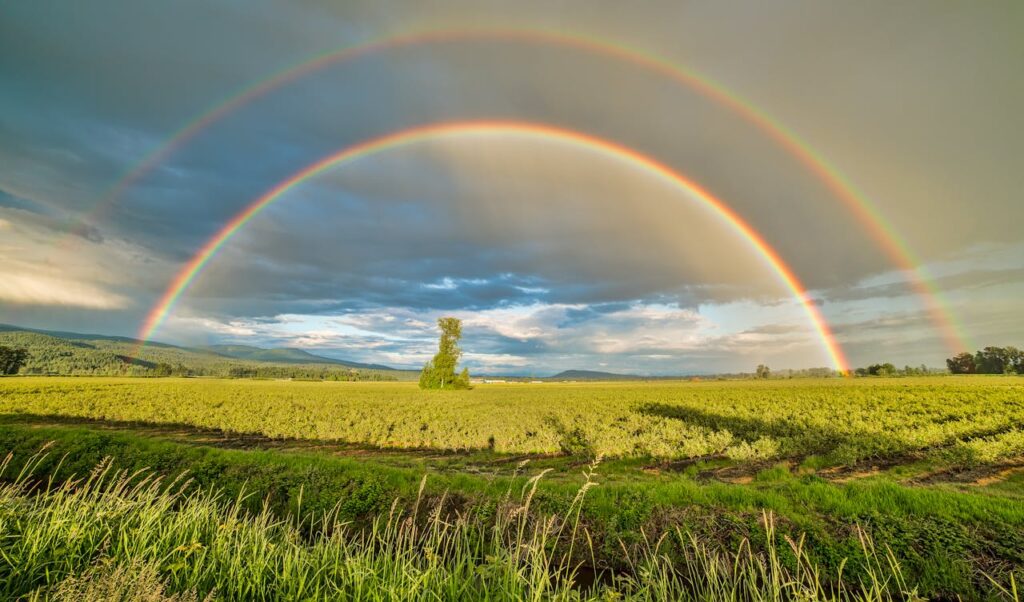
Double Rainbow
A double rainbow is an awe-inspiring sight where two colorful arcs appear. The primary and secondary rainbows form this phenomenon. The secondary rainbow is fainter, and its colors are inverted compared to the primary bow.
Supernumerary Rainbow
A supernumerary rainbow may appear in rare instances. This type of rainbow consists of several faint, pastel-colored bands inside the primary rainbow. This results from the interference of light waves, creating additional, closely spaced arcs.
Full Circle Rainbow
Most people see rainbows as semi-circles, but rainbows are full circles. Observing a complete circle rainbow is possible from high viewpoints, like an airplane. The visible arch of a rainbow results from the horizon blocking the lower half.
Fun Facts About Rainbows
- Rainbows and Greek Mythology: In ancient times, Greeks believed that rainbows were paths made by the messenger goddess Iris.
- Irish Legends: According to Irish legend, a pot of gold can be found at the end of a rainbow.
- Colors of the Rainbow: The main colors of a rainbow are red, orange, yellow, green, blue, indigo, and violet. These are the colors of the visible spectrum.
- Rainbows and Norse Mythology: In Norse mythology, Bifrost is the rainbow bridge connecting Earth to Asgard, the realm of gods.
- Rainbows in Hindu Culture: Rainbows are seen as bows used by the god Indra to shoot arrows of lightning.
Rainbow Facts: Frequently Asked Questions
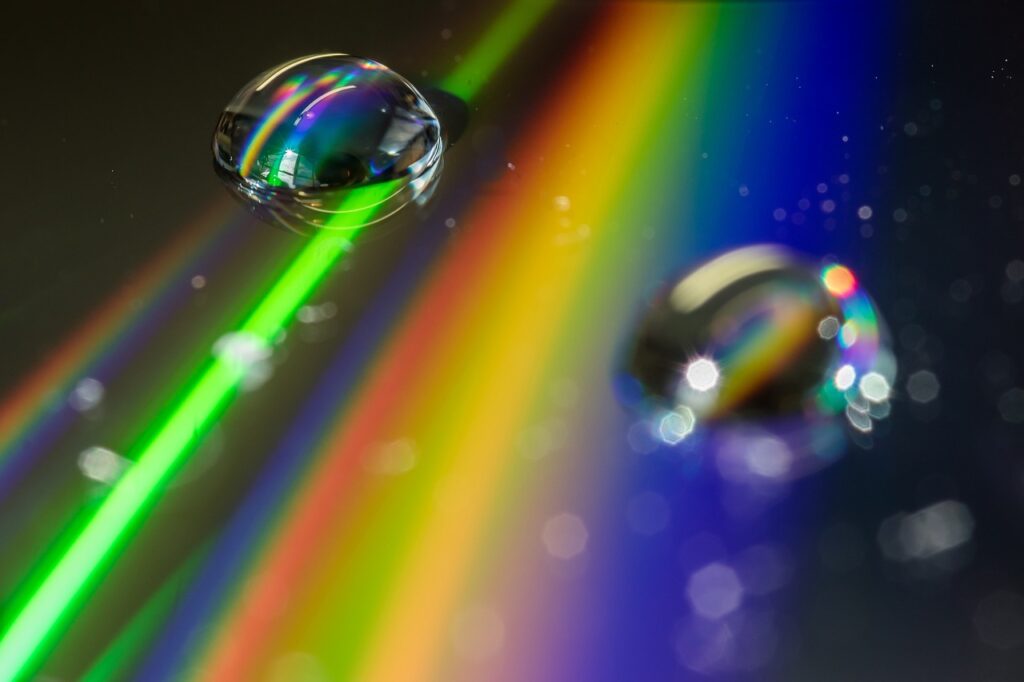
What causes a rainbow to form?
Rainbows form due to the reflection, refraction, and dispersion of light in water droplets, resulting in a spectrum of light appearing in the sky.
Can rainbows form at any time of the day?
Rainbows are typically seen when the sun is low in the sky, either early in the morning or late afternoon, during or after a rain shower.
How can I create my own rainbow?
An easy way to create a rainbow is by using a garden hose. Spray water in the air on a sunny day and stand with your back to the sun. A colorful arc should appear as sunlight shines through the water droplets.
Is it possible to see a full circle rainbow?
Yes, seeing a full circle rainbow is possible from a high vantage point, such as an airplane. Normally, only a semi-circle rainbow is visible from the ground.
What are the different types of rainbows?
There are several types of rainbows, including primary rainbows, secondary rainbows, double rainbows, supernumerary rainbows, and full circle rainbows.
Rainbow Activities for Kids
Create a Rainbow with a Paper Towel
One fascinating activity involves using capillary action to create a rainbow. This fun rainbow craft requires only a few simple materials:
- Materials Needed:
- Paper towel
- Food colorings (red, yellow, blue)
- Water
- Small cups
- Steps to Follow:
- Fold the paper towel in half.
- Fill three cups with water and add a few drops of food coloring to each (one red, one yellow, one blue).
- Place one end of the paper towel in the red-colored water and the other end in the blue-colored water, letting the middle part dip into the yellow water.
- Watch as the colors travel up the paper towel, blending to create a rainbow effect.
Draw and Color a Rainbow
Encourage creativity by having children draw and color their own rainbows. Providing a rainbow coloring page can help younger kids learn the sequence of rainbow colors: red, orange, yellow, green, blue, indigo, and violet.
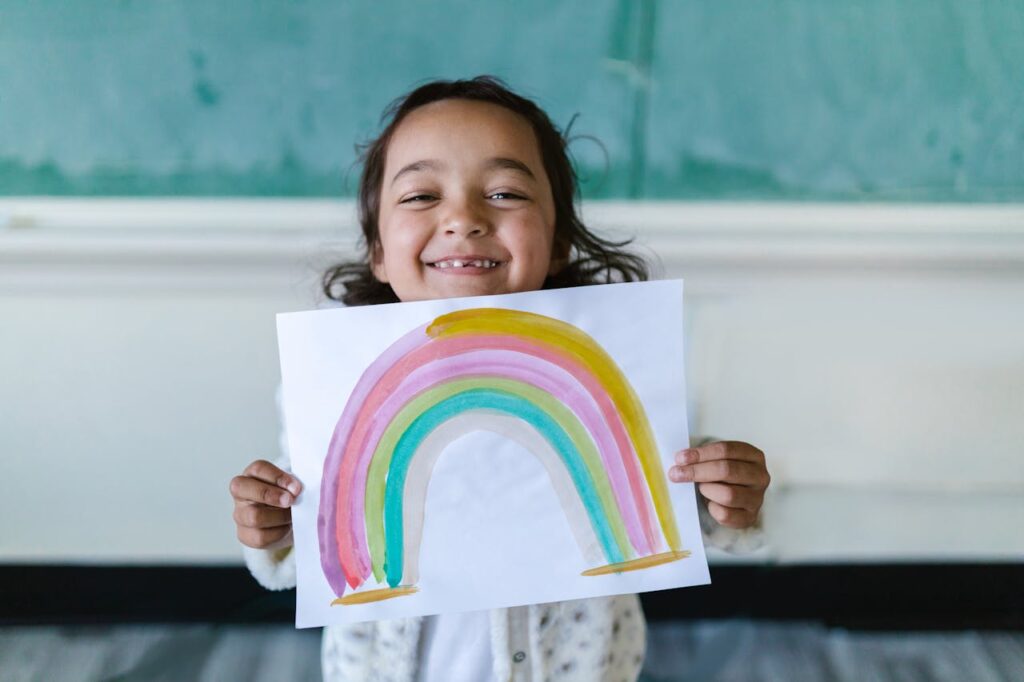
Make a Rainbow with a Prism
A prism can be used to demonstrate how white light bends and splits into different colors. This activity shows kids the spectrum of light and how each color emerges from white light.
- Materials Needed:
- Glass prism
- White paper
- Sunny day or a bright light source
- Steps to Follow:
- Place the prism on the white paper in direct sunlight or in the beam of a bright light.
- Adjust the angle of the prism until a rainbow appears on the paper.
- Observe the different colors of the rainbow and discuss how the prism separates the light into its individual colors.
Rainbow Facts for Kids
Interesting Rainbow Facts
Rainbows are more than just beautiful sights; they have interesting facts that captivate young minds. Here are some cool facts about rainbows:
- Colors of the Rainbow: There are seven main colors in a rainbow: red, orange, yellow, green, blue, indigo, and violet. These colors are part of the visible spectrum of light.
- Rainbows Can Be Seen Around the World: Rainbows are a natural spectacle visible anywhere on Earth where there is rain and sunlight.
- Double Rainbows: Occasionally, double rainbows appear, with the secondary bow being dimmer and having reversed colors.
- Rainbows and Ancient Times: Throughout history, rainbows have been part of myths and legends in various cultures. For example, in Greek mythology, they were seen as paths created by the goddess Iris.
- End of the Rainbow: Despite the popular myth, there is no end to a rainbow. It is a full circle, but the ground usually obstructs the view, making it appear as a semi-circle.
Types of Rainbows

Rainbows can appear in different forms and types, each offering a unique spectacle:
- Primary Rainbow: The most common type, created by one reflection inside a water droplet.
- Secondary Rainbow: Formed by two reflections inside a droplet, usually fainter with reversed colors.
- Supernumerary Rainbow: Features extra, fainter bands inside the primary rainbow, caused by light wave interference.
- Full Circle Rainbow: Visible from high altitudes, showing the complete circle of the rainbow.
- Red Rainbow: Seen during sunrise or sunset, where the red color dominates due to the shorter path of light through the atmosphere.
Rainbow Facts: Frequently Asked Questions Continued
Why do rainbows form a circular arc?
Rainbows form a circular arc because of the way light bends and reflects inside water droplets. The light travels through the droplet and exits at a consistent angle, creating a circle. However, the ground often obstructs the bottom half, making it appear as a semi-circle.
Can you touch a rainbow?
No, a rainbow is an optical illusion created by light. It cannot be touched because it does not exist in a specific location. It appears differently from various viewpoints, meaning each person sees their own rainbow.
Are there different types of rainbows?
Yes, there are several types of rainbows, including primary rainbows, secondary rainbows, double rainbows, supernumerary rainbows, and full circle rainbows. Each type has unique characteristics and formation processes.
The Cultural Significance of Rainbows
Rainbows in Various Cultures
Rainbows have held significant meanings across different cultures and historical periods:
- Greek Mythology: In ancient Greek mythology, rainbows were believed to be paths made by Iris, the messenger goddess, to connect gods and humans.
- Norse Mythology: In Norse mythology, Bifrost was a rainbow bridge that connected Midgard (Earth) to Asgard, the realm of the gods.
- Hindu Culture: In Hindu mythology, the rainbow is considered the bow of Indra, the god of thunder and rain.
- Irish Legends: According to Irish folklore, a pot of gold can be found at the end of a rainbow, guarded by leprechauns.
- The Epic of Gilgamesh: One of the oldest stories in the world, the Epic of Gilgamesh, also mentions rainbows as a sign from the gods.
Rainbows and Science
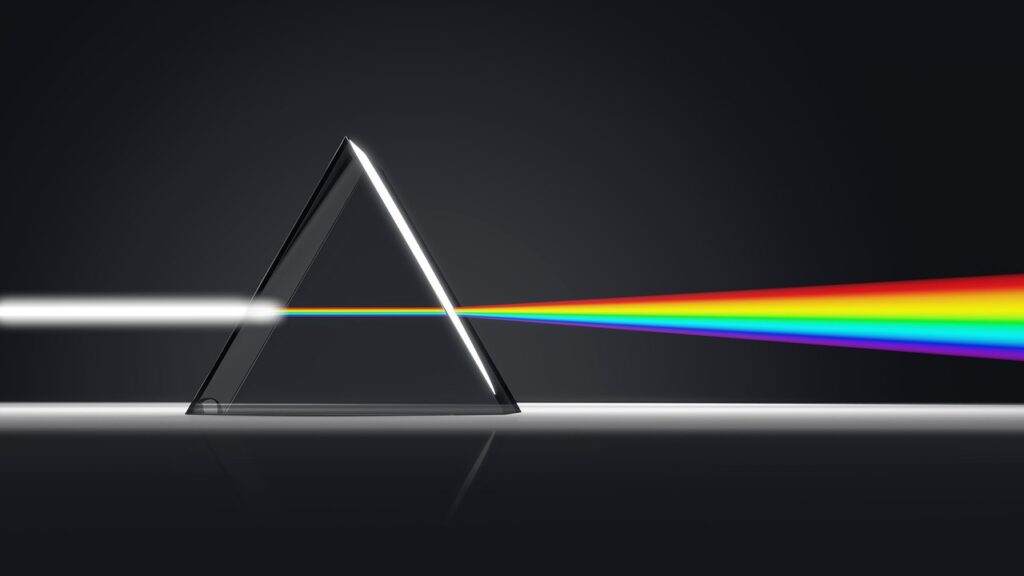
Rainbows have fascinated scientists for centuries. Therefore the study of rainbows are helping us understand the behavior of light and its interaction with water droplets.
Different Wavelengths of Light
Light is made up of different wavelengths, each corresponding to a specific color. When white light bends and splits, these wavelengths separate, creating the distinct colors of a rainbow. The shorter wavelengths like blue and violet bend more than longer wavelengths like red.
The Role of Water Droplets
Water droplets act as tiny prisms that refract and reflect light. The size of the droplets can affect the appearance of a rainbow. Smaller droplets create fainter rainbows with less distinct colors, while larger droplets produce brighter and more vivid arcs.
Rainbow Colors and Their Order
The colors of a rainbow always appear in a specific order due to the consistent way light is refracted and reflected inside water droplets:
- Red: This color is always on the outer edge of the primary rainbow.
- Orange
- Yellow
- Green
- Blue
- Indigo
- Violet: This color is always on the inner edge of the primary rainbow.
Fun Rainbow Crafts for Kids
Engaging kids in rainbow-themed crafts can be both educational and entertaining. Here are a few ideas:
Rainbow Paper Craft
- Materials Needed:
- White paper
- Markers or crayons
- Scissors
- Glue
- Steps to Follow:
- Draw and color a rainbow on the white paper using markers or crayons.
- Cut out the rainbow shape.
- Create a background scene with clouds, a sun, and maybe even a pot of gold.
- Glue the rainbow onto the background to complete the craft.
DIY Rainbow with a Garden Hose
On a sunny day, a garden hose can be used to create a rainbow in your backyard. Simply spray water into the air and stand with your back to the sun. Adjust the angle until you see a colorful arc forming.
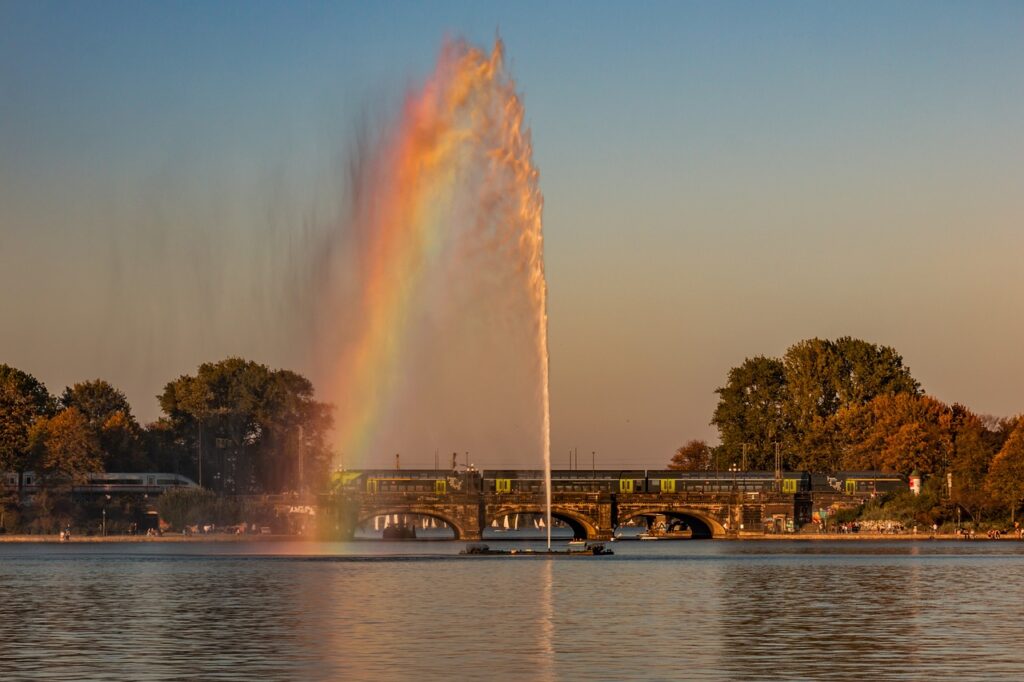
Fascinating Rainbow Facts
Rainbows continue to amaze and inspire people around the world. Here are some more interesting facts:
- Rainbow Colors Can Vary: While the main colors of a rainbow are ROY G. BIV, sometimes other colors can appear due to varying atmospheric conditions and the presence of additional water droplets.
- Rainbows Can Be Seen in Different Places: Rainbows are visible wherever there is a source of light and rain droplets, making them a global phenomenon.
- Rainbows in Space: Earth is the only planet in our solar system where rainbows can form because it has the necessary combination of sunlight and liquid water.
Rainbow Facts: Frequently Asked Questions Continued
Why do some rainbows look brighter than others?
The brightness of a rainbow depends on the size of the water droplets and the intensity of the light source. Larger droplets and brighter sunlight result in more vivid and striking rainbows.
What is a supernumerary rainbow?
A supernumerary rainbow consists of additional, faintly colored bands inside the primary rainbow. These extra bands are caused by the interference of light waves within the water droplets, creating closely spaced arcs.
Can animals see rainbows?
Yes, animals can see rainbows. However, their perception of the colors may differ from humans due to variations in their vision capabilities.
Do rainbows have a universal meaning?
While rainbows have different cultural meanings, they universally symbolize hope, promise, and beauty across various traditions and societies.
Exploring the Spectrum of Light
Understanding the science behind rainbows involves delving into the spectrum of light. The visible spectrum consists of all the colors that can be seen by the naked eye. When white light passes through a medium like a water droplet, it splits into these component colors, creating a rainbow.
White Light and Refraction
White light, such as sunlight, is made up of different colors, each with its own wavelength. When this light enters a water droplet, it slows down and bends. This bending, or refraction, causes the light to split into its constituent colors. In fact each color bends at a slightly different angle, resulting in a spectrum of colors.
Reflection Inside the Droplet
After the light is refracted, it reflects off the inner surface of the water droplet. This reflection changes the light’s direction. The light is then refracted again as it exits the droplet, bending further and spreading out to form the rainbow.
The Role of Angles
The angle at which light enters and exits the water droplet is crucial in forming a rainbow. Typically, the light exits the droplet at an angle of about 42 degrees from its original direction. This consistent angle is why rainbows appear as circular arcs.
Fun Rainbow Experiments
Engaging in experiments can make learning about rainbows more interactive and fun for kids.

Make a Rainbow with a CD
A simple and fun experiment to create a rainbow involves using a CD and a flashlight.
- Materials Needed:
- CD or DVD
- Flashlight
- White paper
- Steps to Follow:
- Place the CD on a flat surface with the shiny side up.
- Shine the flashlight onto the CD at an angle.
- Hold the white paper above the CD to catch the reflected light.
- Observe the rainbow patterns that appear on the paper.
Creating Rainbows with Water and a Mirror
Another exciting experiment uses a mirror submerged in water to produce a rainbow.
- Materials Needed:
- Shallow dish
- Water
- Small mirror
- Flashlight
- Steps to Follow:
- Fill the shallow dish with water.
- Place the mirror in the water at an angle.
- Shine the flashlight onto the mirror.
- Adjust the angle until you see a rainbow reflected on the wall or ceiling.
The Magic of Rainbow Pictures
Capturing rainbow pictures can be a delightful hobby. Here are some tips for taking beautiful rainbow photos:
- Use a Polarizing Filter: A polarizing filter can enhance the colors of a rainbow, making them more vivid in your photographs.
- Right Timing: Rainbows are best captured early in the morning or late in the afternoon when the sun is low.
- Find the Right Angle: Position yourself with your back to the sun to see the rainbow in front of you.
- Include a Landmark: Adding a recognizable landmark or natural feature can provide context and scale to your rainbow photo.
Rainbow Facts: Frequently Asked Questions Continued
How many colors are there in a rainbow?
A rainbow typically has seven colors: red, orange, yellow, green, blue, indigo, and violet. These colors form the visible spectrum of light.
Can rainbows appear at night?
Yes, rainbows can appear at night and are called moonbows. They are created by the light of the moon reflecting off water droplets. Moonbows are fainter and often appear white due to the lower light levels at night.
What is Alexander’s band?
Alexander’s band is a dark area that appears between the primary and secondary rainbows. This phenomenon occurs because of the way light is scattered and reflected within water droplets.
Do other planets have rainbows?
Earth is the only known planet where rainbows can form, due to its unique combination of sunlight and liquid water. However, similar optical phenomena might occur on other planets with the right atmospheric conditions.
Rainbow Facts Conclusion

Rainbows are truly one of nature’s most captivating spectacles, fascinating kids and adults alike. From understanding the science behind their formation to exploring various cultural significances, there is much to learn about these colorful arcs.
Read my article: The Best 22 Intriguing Facts About Diamonds
Engaging in fun activities and experiments can deepen children’s appreciation for rainbows, making science both enjoyable and educational.
Next time you see a rainbow, you’ll know more about the magic and science that create this beautiful natural wonder.
Remember, whether you’re looking for fun rainbow facts for kids or trying to capture the perfect rainbow picture, there’s always more to discover about these mesmerizing arcs in the sky.




